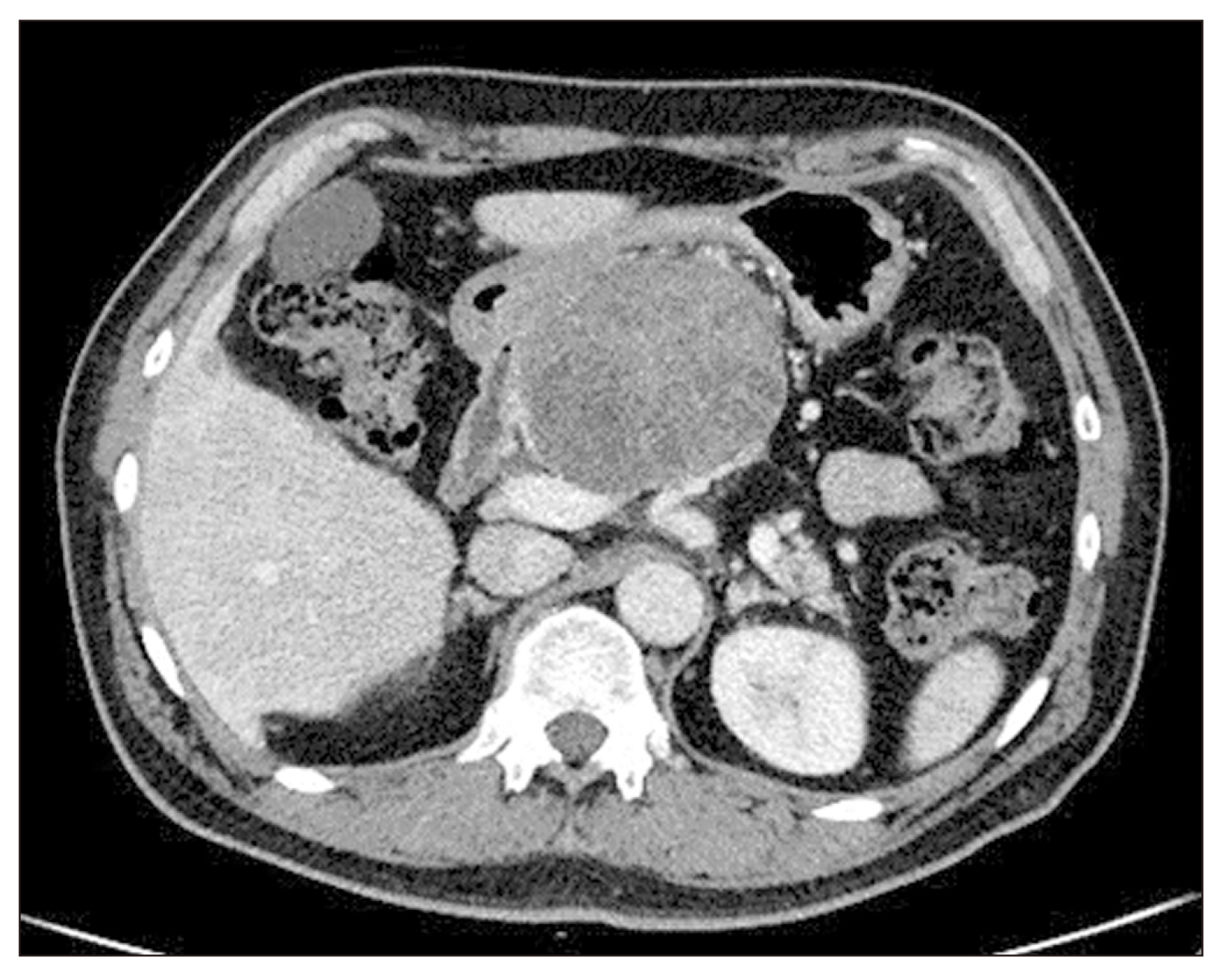Ann Hepatobiliary Pancreat Surg.
2023 May;27(2):217-219. 10.14701/ahbps.22-050.
Serous cystic neoplasm: Do we have to wait till it causes trouble? Season 2
- Affiliations
-
- 1Division of Hepatobiliary and Pancreatic Surgery, Department of Surgery, Yonsei University College of Medicine, Seoul, Korea
- 2Pancreatobiliary Cancer Center, Yonsei Cancer Center, Severance Hospital, Seoul, Korea
- KMID: 2542587
- DOI: http://doi.org/10.14701/ahbps.22-050
Abstract
- A 50-year-old male presented gradually growing pancreatic body mass. An abdominal computed tomography showed a 9.9-cm mass, larger than the 8.9-cm mass one year ago. As the patient did not have complaints for any symptomatic problems, the gastroenterologist decided to check it with regular follow-up. However, as the tumor grew faster than expected, the patient was recommended for surgical resection. Laparoscopic pylorus preserving pancreaticoduodenectomy was done. Since the tumor abutted to the superior mesenteric vein and the portal vein, wedge resection of vessel was inevitable. Pathology was serous cystadenoma. The patient was discharged without postoperative complications. Herein, we report this case with asymptomatic large serous cystic neoplasm treated by laparoscopic approach. The appropriateness of current guidelines for surgery in serous cystic neoplasm is also discussed.
Figure
Reference
-
1. Kosmahl M, Pauser U, Peters K, Sipos B, Lüttges J, Kremer B, et al. 2004; Cystic neoplasms of the pancreas and tumor-like lesions with cystic features: a review of 418 cases and a classification proposal. Virchows Arch. 445:168–178. DOI: 10.1007/s00428-004-1043-z. PMID: 15185076.
Article2. Hwang HK, Chung YE, Kim HK, Park JY, Choi HJ, Kang CM, et al. 2011; Serous cystic neoplasm: do we have to wait till it causes trouble? Korean J Hepatobiliary Pancreat Surg. 15:134–138. DOI: 10.14701/kjhbps.2011.15.2.134. PMID: 26421029. PMCID: PMC4582553.
Article3. Del Chiaro M, Verbeke C, Salvia R, Klöppel G, Werner J, McKay C, et al. 2013; European experts consensus statement on cystic tumours of the pancreas. Dig Liver Dis. 45:703–711. DOI: 10.1016/j.dld.2013.01.010. PMID: 23415799.
Article4. King JC, Ng TT, White SC, Cortina G, Reber HA, Hines OJ. 2009; Pancreatic serous cystadenocarcinoma: a case report and review of the literature. J Gastrointest Surg. 13:1864–1868. DOI: 10.1007/s11605-009-0926-3. PMID: 19459016. PMCID: PMC2759006.
Article5. Liu QY, Zhou J, Zeng YR, Lin XF, Min J. 2016; Giant serous cystadenoma of the pancreas (>10 cm): the clinical features and CT findings. Gastroenterol Res Pract. 2016:8454823. DOI: 10.1155/2016/8454823. PMID: 27610132. PMCID: PMC5004016.6. Jais B, Rebours V, Malleo G, Salvia R, Fontana M, Maggino L, et al. 2016; Serous cystic neoplasm of the pancreas: a multinational study of 2622 patients under the auspices of the International Association of Pancreatology and European Pancreatic Club (European Study Group on Cystic Tumors of the Pancreas). Gut. 65:305–312. DOI: 10.1136/gutjnl-2015-309638. PMID: 26045140.7. Peng C, Zhou D, Meng L, Cao Y, Zhang H, Pan Z, et al. 2019; The value of combined vein resection in pancreaticoduodenectomy for pancreatic head carcinoma: a meta-analysis. BMC Surg. 19:84. DOI: 10.1186/s12893-019-0540-6. PMID: 31286916. PMCID: PMC6615269.
Article8. Hwang HK, Kim H, Kang CM, Lee WJ. 2012; Serous cyst adenoma of the pancreas: appraisal of active surgical strategy before it causes problems. Surg Endosc. 26:1560–1565. DOI: 10.1007/s00464-011-2070-x. PMID: 22179458. PMCID: PMC3351602.
Article9. Malleo G, Bassi C, Rossini R, Manfredi R, Butturini G, Massignani M, et al. 2012; Growth pattern of serous cystic neoplasms of the pancreas: observational study with long-term magnetic resonance surveillance and recommendations for treatment. Gut. 61:746–751. DOI: 10.1136/gutjnl-2011-300297. PMID: 21940725.
Article10. Tseng JF, Warshaw AL, Sahani DV, Lauwers GY, Rattner DW, Fernandez-del Castillo C. 2005; Serous cystadenoma of the pancreas: tumor growth rates and recommendations for treatment. Ann Surg. 242:413–419. discussion 419–421. DOI: 10.1097/01.sla.0000179651.21193.2c. PMID: 16135927. PMCID: PMC1357749.11. Esposito A, Balduzzi A, De Pastena M, Fontana M, Casetti L, Ramera M, et al. 2019; Minimally invasive surgery for pancreatic cancer. Expert Rev Anticancer Ther. 19:947–958. DOI: 10.1080/14737140.2019.1685878. PMID: 31661984.
Article
- Full Text Links
- Actions
-
Cited
- CITED
-
- Close
- Share
- Similar articles
-
- Serous Cystic Neoplasm: Do We Have to Wait Till It Causes Trouble?
- Differential diagnosis of cystic diseases of pancreas
- A Serous Cystic Neoplasm of the Pancreas with Synchronous Pancreatic Ductal Adenocarcinoma
- Malignant Pancreatic Serous Cystic Neoplasm: A Case of Local Recurrence and Liver Metastasis that Occurred During Follow-Up
- Cystic Neoplasm of the Pancreas: Its Diagnosis and Treatment



